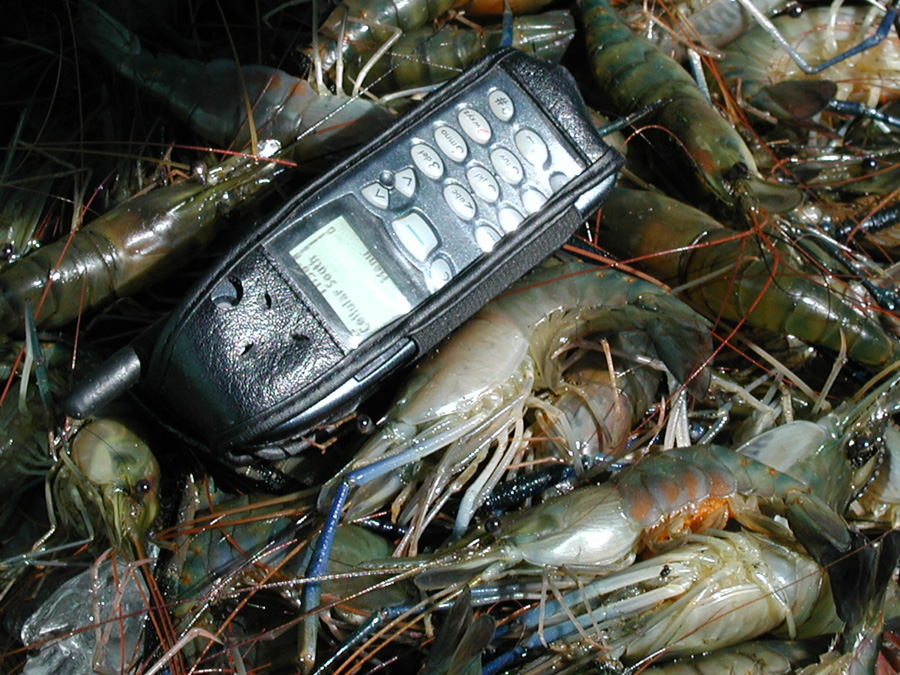
Experiment I in the Year 2000
Experiments using different protein levels in the production of freshwater prawns in 1/4-acre ponds were conducted at the MSU-Coastal Aquaculture Unit with support from Land O'Lakes Farmland Feed LLC. The objective of this experiment was to determine the effects of different protein contents on the survival, count, yield and feed conversion of freshwater prawns raised in ponds. Twelve ponds consisting of three control ponds and nine treatment ponds were used in the experiment. Each pond was stocked on June 15, 2000, with 4,500 45-day-old juveniles weighing 0.15 g each and harvested after 120 culture days. Feeding schedules were prepared for three feeding periods: first 30 days, second 30 days and last 60 days. A daily ration of cottonseed meal was provided during the first 30 days at a rate of 20 lb/acre. For the control ponds, the prawns were fed with 32% protein pelletized sinking catfish feed (SCF32) from day 31 until harvest time. The first three treatment ponds were fed with SCF32 from day 31 to day 60 and with 35% protein extruded sinking shrimp feed (SSF35) from day 61 until harvest time. The second set of three treatment ponds was fed with SCF32 during the second period and with 40% protein extruded sinking shrimp feed (SSF40) during the final period. The final set of three treatment ponds was fed with SSF35 from day 31 until harvest time. All feed was broadcast along four sides of each of the 12 ponds two times daily, around 8-9 A.M. and 4-5 P.M. Dissolved oxygen and temperature were monitored daily while salinity, pH, total ammonia, nitrogen, and nitrite were measured on a biweekly basis. With the use of partial budgets, the results of this experiment were used to evaluate the added returns and costs associated with the use of different protein levels in freshwater prawn pond grow-out culture.
The use of extruded feed with higher protein levels in experimental prawn pond grow-out production in Coastal Mississippi did not necessarily lead to higher prawn yields. Analysis of variance (ANOVA) results showed that the use of extruded feed with higher protein levels did not have any statistically significant effects on prawn survival rate, harvest size or count, yield and feed conversion. Prawn yields averaged 1,049 kg/ha. Survival rates averaged 50.7%, prawn counts were 21.8 pcs/kg and the gross feed conversion ratio was 3.5 kg of feed per kg of prawn produced. Although it was not significantly different, better survival, count, yield and feed conversion were observed among ponds with CCF32. These results, however, indicated that 0.10-ha pond yields averaging 1,049 kg/ha consisting of 21.8 prawns/kg were attainable at a stocking density of 44,478 pl/ha.
Experiment II in the Year 2001
Six 0.25-acre ponds were used to compare pond production of freshwater prawns using two different feed formulations with continued support from Land O'Lakes Farmland Feed LLC. The ponds were filled with water from the discharge canal of a nearby power plant starting on April 1. Soil pH was tested and an appropriate amount of dolomitic lime was applied before flooding. All ponds were treated with rotenone 30 days before stocking and appropriate amounts of liquid fertilizer were applied to each pond after flooding. Each pond was stocked on May 15 with 5,000 30-day-old juveniles weighing 0.15 g each, equivalent to 20,000 PL/acre. Weekly feeding schedules based on the Year 2000 prawn feeding were prepared for three feeding periods, namely: first 30 days, second 30 days and last 60 days. A daily ration of cottonseed meal (CSM) was provided during the first 30 days at a rate of 20 lb/acre. For the control ponds, the prawns were fed a 32% protein pelletized sinking catfish feed (SCF32) from day 31 until harvest time. The three treatment ponds were fed a 35% protein pelletized sinking shrimp feed (SSF35) from day 31 until harvest time. The feed was broadcast along four sides of each pond twice daily, around 8-9 A.M. and 4-5 P.M. Monthly sampling was conducted to estimate prawn growth and biomass, and adjust weekly feeding schedules. Dissolved oxygen and temperature were monitored daily while salinity, pH, total ammonia, and nitrite will be measured on a monthly basis. These daily and monthly data were being used to manage the ponds and statistically analyzed as part of the project report. Prawns were harvested after 120 days by draining each pond with an adequately screened drain pipe. The following data were collected during harvest and compared statistically, namely: prawn yield, percent survival rate, harvest size, feed conversion, and processing yield. It is recommended to maintain the following optimal water quality parameters during the grow-out period: pH – 7.5-8.5; DO – at least 4 ppm; total alkalinity – at least 80 ppm; hardness – below 300 ppm; ammonia – not more than 0.1 ppm; water transparency – 12-16 inches of Secchi disc visibility.
The use of pelletized shrimp feed with higher protein level in experimental prawn pond grow-out led to significantly higher prawn yields. Prawn yield in ponds fed with CCF32 averaged 1,126 lb/ac or 1,262 kg/ha while ponds provided with SSF35 produced 1,350 lb/ac or 1,513 kg/ha. Although prawn count was similar in both treatments, survival rates were higher in ponds fed with the experimental shrimp diet. Using these experimental results in a hypothetical single-enterprise commercial freshwater prawn farm consisting of 50, 2-acre ponds, the average cost of production is about $2.80/lb or $6.20/kg, if prawns are fed with CCF32. Despite the higher cost of SSF35, the average cost of production, if prawns are fed with this feed, is about $2.65/lb or $5.80/kg.
